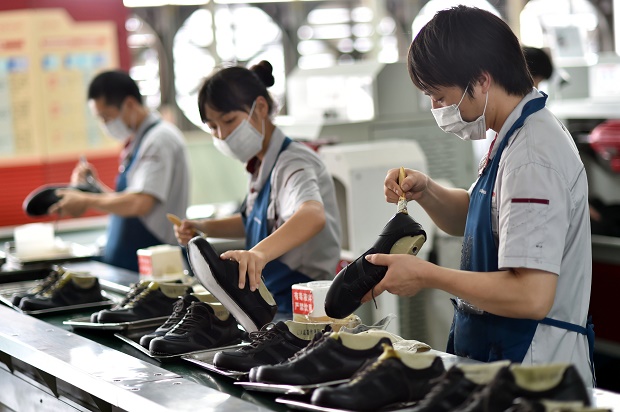China manufacturing expands for third straight month — govt

In this July 29, 2015 photo, workers assemble shoes in a shoe factory in Yongjia county in eastern China’s Zhejiang province. AP
BEIJING, China — Activity in Chinese factories expanded for the third straight month in May, official data showed, a further sign of stabilization in the world’s second largest economy.
The official Purchasing Manager’s Index (PMI), which tracks activities in the country’s factories and workshops, came in at 50.1 on Wednesday, according to the National Bureau of Statistics (NBS).
Any reading above 50 signals expanding activity, while anything below indicates shrinkage.
The figure was unchanged from April but beat economists’ median expectations of 50 in a survey by Bloomberg News.
Investors watch the figure closely as the first available indicator each month of the health of the world’s second biggest economy.
Article continues after this advertisementChina’s economy is a vital driver of global expansion. But it grew only 6.9 percent last year, its weakest rate in a quarter of a century.
Article continues after this advertisementThe key manufacturing sector has been struggling for months in the face of sagging global demand for Chinese products.
Analysts with ANZ Research said the results were lifted by property investment and fiscal policies and ruled out any imminent “broad-based monetary policy easing” as China’s leaders “do not welcome property-led growth” in the first quarter.
“What is worth paying attention to is that the growth rate of raw material prices declined, showing that market demand remained rather weak and the foundation for manufacturing growth is still unstable,” NBS analyst Zhao Qinghe said in a statement, referring to the May figure.
China’s economy is “operating steadily” now but is “lacking any upward momentum”, Tao Dong of Credit Suisse told Bloomberg News, adding that the economy “will wane again in the summer”, which will be a “key test” for the central bank to keep policies stable.
The signs were less positive from the private Caixin Purchasing Managers’ Index, which puts a greater emphasis on smaller firms.
That figure came in at 49.2, meeting economists’ expectations of a fractional decline from 49.4 in April, the Chinese financial magazine said in a joint statement with data compiler Markit.
Manufacturers continued to shed jobs as weak demand and a drop in new orders weighed on the figures, it said.
“Overall, China’s economy has not been able to sustain the recovery it had in the first quarter and is in the process of bottoming out,” Zhao Zhengsheng, director of Macro economic Analysis at CEBM Group said.
“The government still needs to make full use of proactive fiscal policy measures accompanied by a prudent monetary policy to prevent the economy from slowing further.”
Chinese stocks opened slightly higher on Wednesday morning, with the benchmark Shanghai Composite Index edging up 0.02 percent.